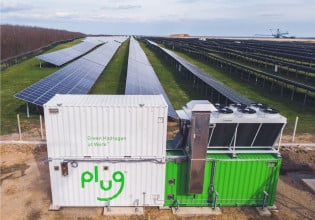Creating Protonic Ceramic Fuel Cells With Iron-based Cathodes
Researchers from the Hong Kong University of Science and Technology have developed a low-cost, scalable cathode material for record-performing protonic ceramic fuel cells.
The Hong Kong University of Science and Technology (HKUST) recently announced the latest research concerning the development of an iron-based cathode that led to a protonic ceramic fuel cell (PCFC) with record performance.

Professor Ciucci shows a PCFC made with D-BFZ. Image used courtesy of HKUST
Protonic Ceramic Fuel Cells Don’t Emit Carbon Dioxide
Fuel cells are electrochemical devices that convert chemical energy from a fuel (typically hydrogen) into electrical energy. In a fuel cell, hydrogen reacts with oxygen to generate heat, water, and electricity. PCFCs can also use other gases such as biogas, methane, and ammonia.
PCFCs are considered the new kid on the block among other technologies in the fuel cell industry. These fuel cells use ceramic electrolytes, and protons incorporated into the ceramic lattice structure can be carried with activation energies of 0.5 electron volts (eV) or lower.

How fuel cells work. Image used courtesy of Adobe Stock
Previous research has highlighted some attractive qualities of PCFCs including low activation energy at below 600 degrees Celsius and high proton conductivity. Another interesting facet of the PCFC is that it does not suffer from fuel dilution in the way that oxide ions conducting solid oxide fuel cells (SOFCs) do.
PCFCs can benefit a future low-carbon society as they do not emit carbon dioxide, a potent greenhouse gas. However, they do emit water, which is in fact a greenhouse gas. With this regard, careful calculations must be made to make sure one problem is not traded in for another.
According to Fortune Business Insights, the global PCFC market stood at a value of $46.5 million in 2021. The market is expected to grow from $58.7 million in 2022 to $396.6 million by 2029 at a compound annual growth rate (CAGR) of 31.4 percent.
Researchers Focus on Producing Low-cost Cathode
The HKUST researchers led by Professor Francesco Ciucci from the Department of Mechanical & Aerospace Engineering and Department of Chemical & Biological Engineering, focused their efforts on generating a low-cost iron-based cathode, negating the use of a more toxic and expensive alternative, cobalt.
Together, the team experimented with different ceramic materials, using iron (Fe), barium (Ba), and zirconium (Zr). The researchers also added molecular orbital analysis and principle simulations to their experimental work. Cathode materials were synthesized by using fundamental physical-chemical principles and a kind of electronic structure calculation known as density functional theory (DFT).
Eventually, the researchers identified a cathode material that looked promising, Ba0.875Fe0.875Zr0.125O3-δ (D-BFZ). Not only did the material exhibit high operational stability and peak power density, but it also was found to be suitable for mass production.
The researchers are continuing to develop the technology and believe that if PCFCs are used reversibly, they could help decarbonize heavy-duty transportation, ammonia production, and the iron and steel industry.
The research highlighted here was published in Nature Reviews Materials and Nature Catalysis.
Featured image used courtesy of Adobe Stock






